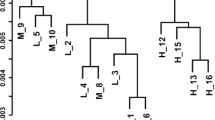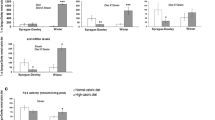Abstract
The aim of this study was to provide a sequential analysis of the expression patterns of key genes involved in lipid metabolism in white adipose tissue (WAT) and liver and their relationship with blood parameters in response to fasting. Adult male rats were studied under different feeding conditions: feeding state, after 4, 8, or 24 h fasting, and after 3 h refeeding after 8 h fasting. Blood parameters and the expression of genes involved in lipogenesis and lipolysis in WAT and liver were analyzed. mRNA levels of genes involved in lipogenesis in liver (SREBP1c, FAS, and GPAT) had already decreased after 4 h fasting, as well as those of PPARgamma in WAT, whereas the decrease in SREBP1c, FAS, GPAT, and GLUT4 mRNA levels in WAT was observed after 8 h. Concerning lipolytic and fatty-acid-oxidation-related genes, liver PPARalpha, FGF21, CPT1, and PDK4 mRNA levels increased after 8 h fasting and those of ACOX1 after 24 h, and in WAT, ATGL, and CPT1 mRNA levels were greater after 24 h. Three hours refeeding increased the expression levels of PPARgamma in WAT, SREBP1c in both liver and WAT, and GPAT in liver, and decreased the expression levels of PPARalpha, CPT1, and PDK4 in liver. These results give new insight into the different adaptive time course response to fasting in the expression of genes involved in lipid metabolism, thus pointing out the very rapid response of lipogenic genes, particularly in liver, and the later response of lipolytic genes, particularly in WAT.




Similar content being viewed by others
References
Barzilai N, Rossetti L (1996) Age-related changes in body composition are associated with hepatic insulin resistance in conscious rats. Am J Physiol 270:E930–E936
Boll M, Weber LW, Stampfl A (1996) Nutritional regulation of the activities of lipogenic enzymes of rat liver and brown adipose tissue. Z Naturforsch [C] 51:859–869
Cagen LM, Deng X, Wilcox HG, Park EA, Raghow R, Elam MB (2005) Insulin activates the rat sterol-regulatory-element-binding protein 1c (SREBP-1c) promoter through the combinatorial actions of SREBP, LXR, Sp-1 and NF-Y cis-acting elements. Biochem J 385:207–216
Corssmit EP, Romijn JA, Sauerwein HP (2001) Review article: Regulation of glucose production with special attention to nonclassical regulatory mechanisms: a review. Metabolism 50:742–755
de Lange P, Farina P, Moreno M, Ragni M, Lombardi A, Silvestri E, Burrone L, Lanni A, Goglia F (2006) Sequential changes in the signal transduction responses of skeletal muscle following food deprivation. Faseb J 20:2579–2581
de Lange P, Moreno M, Silvestri E, Lombardi A, Goglia F, Lanni A (2007) Fuel economy in food-deprived skeletal muscle: signaling pathways and regulatory mechanisms. Faseb J 21:3431–3441
Eaton S, Bartlett K, Pourfarzam M (1996) Mammalian mitochondrial beta-oxidation. Biochem J 320(Pt 2):345–357
Escher P, Braissant O, Basu-Modak S, Michalik L, Wahli W, Desvergne B (2001) Rat PPARs: quantitative analysis in adult rat tissues and regulation in fasting and refeeding. Endocrinology 142:4195–4202
Feige JN, Gelman L, Michalik L, Desvergne B, Wahli W (2006) From molecular action to physiological outputs: peroxisome proliferator-activated receptors are nuclear receptors at the crossroads of key cellular functions. Prog Lipid Res 45:120–159
Finn PF, Dice JF (2006) Proteolytic and lipolytic responses to starvation. Nutrition 22:830–844
Foufelle F, Ferre P (2002) New perspectives in the regulation of hepatic glycolytic and lipogenic genes by insulin and glucose: a role for the transcription factor sterol regulatory element binding protein-1c. Biochem J 366:377–391
Goodman MN, Larsen PR, Kaplan MM, Aoki TT, Young VR, Ruderman NB (1980) Starvation in the rat. II. Effect of age and obesity on protein sparing and fuel metabolism. Am J Physiol 239:E277–E286
Gosmain Y, Dif N, Berbe V, Loizon E, Rieusset J, Vidal H, Lefai E (2005) Regulation of SREBP-1 expression and transcriptional action on HKII and FAS genes during fasting and refeeding in rat tissues. J Lipid Res 46:697–705
Hashimoto T (1999) Peroxisomal beta-oxidation enzymes. Neurochem Res 24:551–563
Hashimoto T, Cook WS, Qi C, Yeldandi AV, Reddy JK, Rao MS (2000) Defect in peroxisome proliferator-activated receptor alpha-inducible fatty acid oxidation determines the severity of hepatic steatosis in response to fasting. J Biol Chem 275:28918–28928
Inagaki T, Dutchak P, Zhao G, Ding X, Gautron L, Parameswara V, Li Y, Goetz R, Mohammadi M, Esser V, Elmquist JK, Gerard RD, Burgess SC, Hammer RE, Mangelsdorf DJ, Kliewer SA (2007) Endocrine Regulation of the Fasting Response by PPARalpha-Mediated Induction of Fibroblast Growth Factor 21. Cell Metab 5:415–425
Joseph SB, Laffitte BA, Patel PH, Watson MA, Matsukuma KE, Walczak R, Collins JL, Osborne TF, Tontonoz P (2002) Direct and indirect mechanisms for regulation of fatty acid synthase gene expression by liver X receptors. J Biol Chem 277:11019–11025
Kersten S, Seydoux J, Peters JM, Gonzalez FJ, Desvergne B, Wahli W (1999) Peroxisome proliferator-activated receptor alpha mediates the adaptive response to fasting. J Clin Invest 103:1489–1498
Kim JB, Sarraf P, Wright M, Yao KM, Mueller E, Solanes G, Lowell BB, Spiegelman BM (1998) Nutritional and insulin regulation of fatty acid synthetase and leptin gene expression through ADD1/SREBP1. J Clin Invest 101:1–9
Kliewer SA, Sundseth SS, Jones SA, Brown PJ, Wisely GB, Koble CS, Devchand P, Wahli W, Willson TM, Lenhard JM, Lehmann JM (1997) Fatty acids and eicosanoids regulate gene expression through direct interactions with peroxisome proliferator-activated receptors alpha and gamma. Proc Natl Acad Sci USA 94:4318–4323
Klover PJ, Mooney RA (2004) Hepatocytes: critical for glucose homeostasis. Int J Biochem Cell Biol 36:753–758
Lemberger T, Saladin R, Vazquez M, Assimacopoulos F, Staels B, Desvergne B, Wahli W, Auwerx J (1996) Expression of the peroxisome proliferator-activated receptor alpha gene is stimulated by stress and follows a diurnal rhythm. J Biol Chem 271:1764–1769
Lundasen T, Hunt MC, Nilsson LM, Sanyal S, Angelin B, Alexson SE, Rudling M (2007) PPARalpha is a key regulator of hepatic FGF21. Biochem Biophys Res Commun 360:437–440
Ma K, Zhang Y, Elam MB, Cook GA, Park EA (2005) Cloning of the rat pyruvate dehydrogenase kinase 4 gene promoter: activation of pyruvate dehydrogenase kinase 4 by the peroxisome proliferator-activated receptor gamma coactivator. J Biol Chem 280:29525–29532
McGarry JD, Brown NF (1997) The mitochondrial carnitine palmitoyltransferase system. From concept to molecular analysis. Eur J Biochem 244:1–14
Nakamura MT, Cheon Y, Li Y, Nara TY (2004) Mechanisms of regulation of gene expression by fatty acids. Lipids 39:1077–1083
Osborne TF (2000) Sterol regulatory element-binding proteins (SREBPs): key regulators of nutritional homeostasis and insulin action. J Biol Chem 275:32379–32382
Palou A, Remesar X, Arola L, Herrera E, Alemany M (1981) Metabolic effects of short term food deprivation in the rat. Horm Metab Res 13:326–330
Pfaffl MW (2001) A new mathematical model for relative quantification in real-time RT-PCR. Nucleic Acids Res e29:45
Priego T, Sanchez J, Pico C, Palou A (2008) Sex-differential expression of metabolic-related genes in response to a high-fat diet. Obesity (Silver Spring) 16:819–826
Roe JH, Dailey RE (1966) Determination of glycogen with the anthrone reagent. Anal Biochem 15:245–250
Ryu MH, Daily JW 3rd, Cha YS (2005) Effect of starvation on hepatic acyl-CoA synthetase, carnitine palmitoyltransferase-I, and acetyl-CoA carboxylase mRNA levels in rats. Nutrition 21:537–542
Scotini E, Caparrotta L, Tessari F, Fassina G (1983) Age-related changes in rat adipose tissue in response to fasting: protein, lactate and pyruvate levels. Life Sci 32:2701–2708
Schoonjans K, Staels B, Auwerx J (1996) Role of the peroxisome proliferator-activated receptor (PPAR) in mediating the effects of fibrates and fatty acids on gene expression. J Lipid Res 37:907–25
Seitz HJ, Muller MJ, Krone W, Tarnowski W (1977) Coordinate control of intermediary metabolism in rat liver by the insulin/glucagon ratio during starvation and after glucose refeeding. Regulatory significance of long-chain acyl-CoA and cyclic AMP. Arch Biochem Biophys 183:647–663
Soler-Argilaga C, Heimberg M (1976) Comparison of metabolism of free fatty acid by isolated perfused livers from male and female rats. J Lipid Res 17:605–615
Sorrentino D, Stump DD, Zhou SL, Van Ness K, Isola LM, Berk PD (1994) The hepatocellular uptake of free fatty acids is selectively preserved during starvation. Gastroenterology 107:1415–1424
Steineger HH, Sorensen HN, Tugwood JD, Skrede S, Spydevold O, Gautvik KM (1994) Dexamethasone and insulin demonstrate marked and opposite regulation of the steady-state mRNA level of the peroxisomal proliferator-activated receptor (PPAR) in hepatic cells. Hormonal modulation of fatty-acid-induced transcription. Eur J Biochem 225:967–974
Sugden MC, Holness MJ (1994) Interactive regulation of the pyruvate dehydrogenase complex and the carnitine palmitoyltransferase system. Faseb J 8:54–61
Sztalryd C, Kraemer FB (1994) Regulation of hormone-sensitive lipase during fasting. Am J Physiol 266:E179–E185
Vidal-Puig A, Jimenez-Linan M, Lowell BB, Hamann A, Hu E, Spiegelman B, Flier JS, Moller DE (1996) Regulation of PPAR gamma gene expression by nutrition and obesity in rodents. J Clin Invest 97:2553–2561
Villena JA, Roy S, Sarkadi-Nagy E, Kim KH, Sul HS (2004) Desnutrin, an adipocyte gene encoding a novel patatin domain-containing protein, is induced by fasting and glucocorticoids: ectopic expression of desnutrin increases triglyceride hydrolysis. J Biol Chem 279:47066–47075
Wu P, Blair PV, Sato J, Jaskiewicz J, Popov KM, Harris RA (2000) Starvation increases the amount of pyruvate dehydrogenase kinase in several mammalian tissues. Arch Biochem Biophys 381:1–7
Zimmermann R, Strauss JG, Haemmerle G, Schoiswohl G, Birner-Gruenberger R, Riederer M, Lass A, Neuberger G, Eisenhaber F, Hermetter A, Zechner R (2004) Fat mobilization in adipose tissue is promoted by adipose triglyceride lipase. Science 306:1383–1386
Acknowledgement
This work was supported by the Spanish Government (grants AGL 2004-07496/ALI, AGL2006–04887/ALI). Our Laboratory is a member of the European Research Network of Excellence NuGO (The European Nutrigenomics Organization, EU Contract: no. FP6–506360). The CIBER de Fisiopatología de la obesidad y nutrición is an initiative of the ISCIII.
Author information
Authors and Affiliations
Corresponding author
Rights and permissions
About this article
Cite this article
Palou, M., Priego, T., Sánchez, J. et al. Sequential changes in the expression of genes involved in lipid metabolism in adipose tissue and liver in response to fasting. Pflugers Arch - Eur J Physiol 456, 825–836 (2008). https://doi.org/10.1007/s00424-008-0461-1
Received:
Revised:
Accepted:
Published:
Issue Date:
DOI: https://doi.org/10.1007/s00424-008-0461-1




